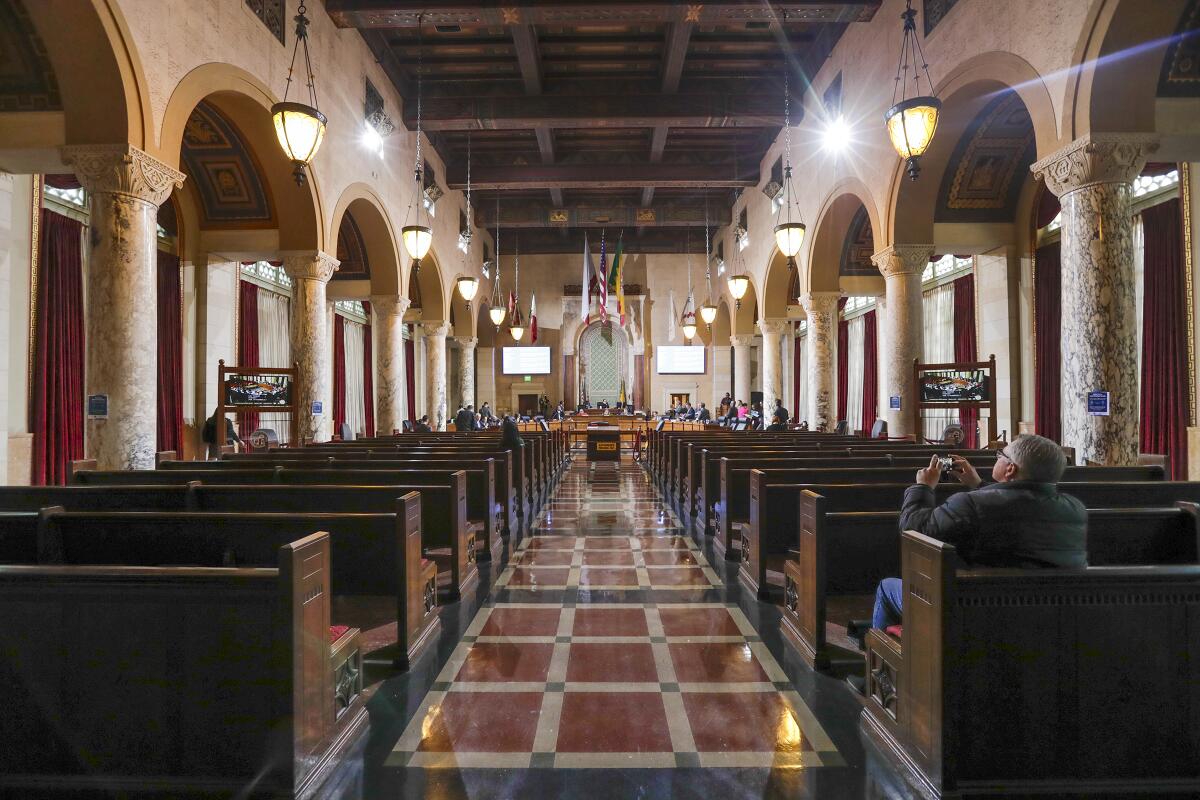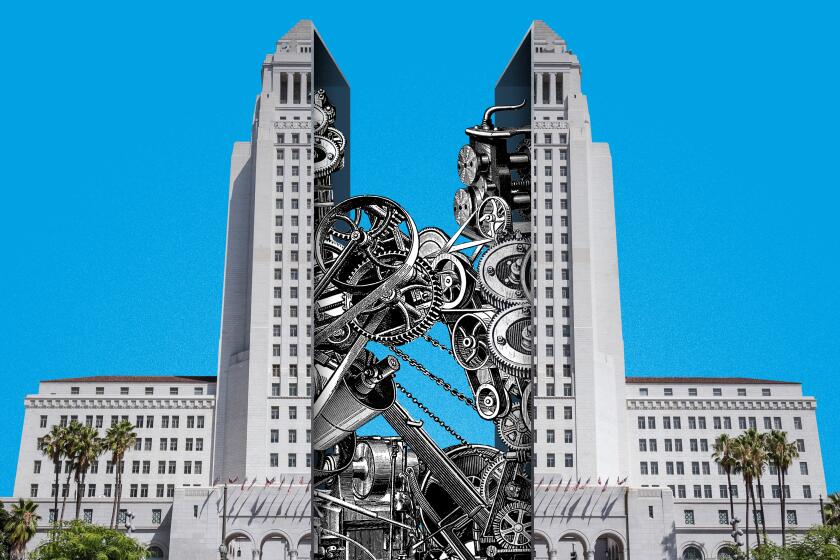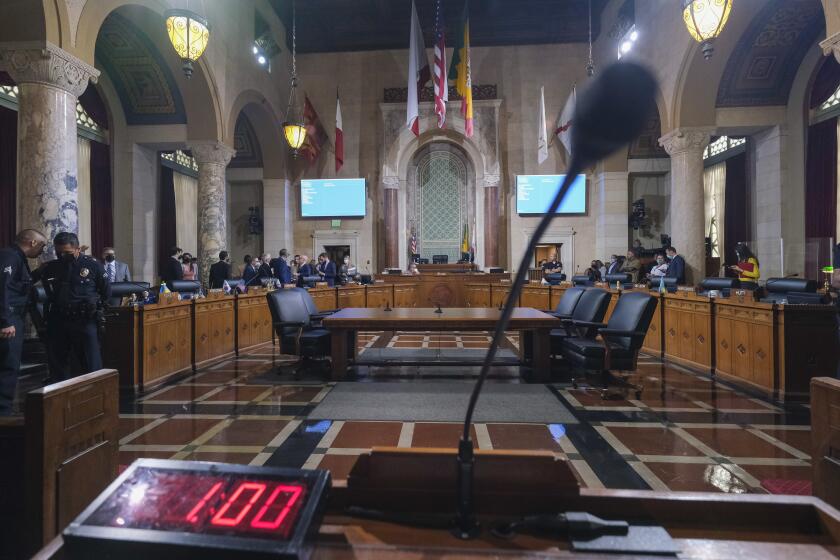Editorial: Why L.A. needs a larger City Council

Los Angeles has nearly 4 million people. You might think the 15-member City Council, with each council member representing around 260,000 people, is normal for a big city.
But it’s not at all typical. L.A.’s council districts are the largest, by population, in the nation. The City Council has had 15 members for nearly a century, unchanged since 1924, when Los Angeles had fewer than 600,000 people and a ratio of about one council member to every 38,000 residents.
These outdated districts, each covering about 34 square miles, are a key reason why city government just doesn’t seem to function.
It’s simply not possible for one person to represent that many people and still provide the localized attention that residents deserve from their council member. One Los Angeles council district has roughly the same population as St. Petersburg, Fla., or Laredo, Texas, cities that have eight council members each.
Los Angeles City Hall has been rocked by scandal after scandal, but now there’s momentum to reform city government.
L.A.’s large council districts and small City Council hurts democracy, community cohesion and fair representation of Latinos, who make up nearly half of the city’s population, and other underrepresented groups. It hinders the ability of government in the nation’s second-largest city to effectively respond to people’s needs and concerns. It’s no wonder residents complain about getting basic requests fulfilled when they are competing with 259,999 other people for assistance. By comparison, San Francisco has about 79,000 residents per district and Long Beach has 52,000 per district.
There had been little discussion about expanding the size of the City Council — and reducing the size of the council districts — until last month, when the leak of a racist recording of three City Council members and a labor leader upended City Hall and suddenly raised the possibility of reform. Within days, Councilmember Mitch O’Farrell offered a motion to take the first steps toward putting a charter reform initiative on the 2024 ballot to increase the number of seats on the City Council.
A recent survey of Los Angeles elected leaders and candidates by The Times editorial board found overwhelming support for enlarging the City Council. All but two of the 25 who responded favored putting a measure on the ballot. Only mayoral candidate Rep. Karen Bass (D-Los Angeles) and 11th Council District candidate Traci Park opposed the idea.
We asked Los Angeles’ elected leaders and candidates if they would support putting a measure on the ballot to enlarge the City Council.
City leaders should waste no time in pushing ahead. More council districts would help improve diversity on the council, most critically for Latinos. Before then-Council President Nury Martinez resigned following the leak of her racist comments, Latinos held only about one-quarter of the seats.
Smaller districts also just make sense, in terms of geography and community identity. There is no good reason why the South L.A. neighborhood of Watts should be in the same district as San Pedro some 15 miles away in the harbor area, or why District 4 should stretch a similarly long distance from Silver Lake all the way to Reseda in the San Fernando Valley. These communities have little in common, and while these districts’ unwieldy shapes are a product of politician-controlled redistricting, they have ballooned to include such impractically high numbers of constituents because the number of council seats has not been adjusted to account for nearly a century of population growth.
Enlarging the council would also help combat the zero-sum politics on display in the disgraced council members’ remarks, where politicians fight over a small number of too-large districts. More council members would mean a larger, more diverse bench of leaders, and less of a hit to the balance of representation each time a member leaves.
Politicians should not choose their voters; it’s a conflict of interest that puts incumbents and their allies’ desires above what’s good for communities.
Smaller districts could empower communities of interest to organize and elect a representative of their choice, like neighborhoods with heavy concentrations of renters, and give them a stronger voice at City Hall. Smaller districts and more council members would also dilute each council member’s relative power, and in combination with other reforms, like independent redistricting and reducing individual members’ power over land use, help make the City Council more like a legislative body than the collection of arbitrary fiefdoms it operates like today.
So how big should the council be?
Hydee Feldstein Soto, a candidate for city attorney, suggested expanding the council to 21 or 25 members. Outgoing City Atty. Mike Feuer has proposed doubling it to 30. Hugo Soto-Martínez, candidate for District 13, said that more than tripling the council to around 50 members, as is the case in Chicago, “would give constituents more power and make it easier to hold their elected leaders accountable.”
An analysis last year by Sonja Diaz, founding director of UCLA Latino Policy & Politics Institute, recommended increasing the size of the City Council by a minimum of seven seats, to at least 22 members, which would reduce the number of residents per district to about 177,000, on par with New York City. Doing so, her analysis found, would give Black, Latino, Asian and Pacific Islander communities a better shot at representation, give more power to Armenian and Jewish communities to form coalitions and allow growing neighborhoods like Playa Vista and downtown L.A. to be in more cohesive, compact districts.
Given the city’s size, doubling the number of council seats may be quite reasonable. But whatever increase leaders decide on, it should be significant enough to meaningfully improve council representation and responsiveness.
Change is possible. Voters in New York City, for instance, approved governmental reforms in 1989 that included expanding the City Council from 35 to 51 members.
The Times asked elected Los Angeles officials and candidates if they support independent redistricting, a larger city council and land-use reforms.
Before that expansion, only nine out of 35 seats on New York’s City Council were held by nonwhite council members. More council seats helped increase Black, Latino and Asian representation in City Hall; in 2021 there were 35 people of color on the 51-member council, said Joseph Viteritti, chair of the urban policy and planning department at Hunter College.
“If improving representation is an objective, it’s certainly a reasonable, time-tested approach to doing it,” Viteritti said.
While support from city leaders is a good start, it doesn’t mean the path ahead will be easy. In 1999, L.A. voters rejected two city charter amendments that would have expanded the City Council to 21 or 25 members.
These are different times, with a more engaged, progressive and fed-up electorate. But you couldn’t blame Angelenos if they are still skeptical of the idea of solving city dysfunction by putting more politicians into office. Consider how many City Council members have left office in just the last few years under allegations of corruption or other misbehavior.
Knowing that, this measure should be crafted with exceeding care and transparency. And proponents must ultimately make a clear and compelling case to voters that a larger council made up of smaller districts would improve delivery of city services and actually dilute each council member’s power while giving residents a greater voice and influence at City Hall.
It’s been clear for decades that L.A.’s City Council needs to be bigger. City leaders and voters should seize this moment and finally make it happen.
More to Read
A cure for the common opinion
Get thought-provoking perspectives with our weekly newsletter.
You may occasionally receive promotional content from the Los Angeles Times.













